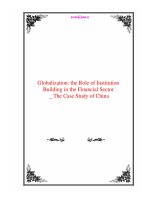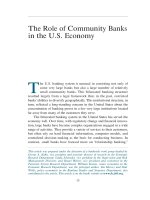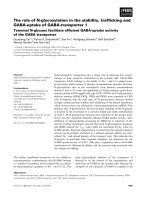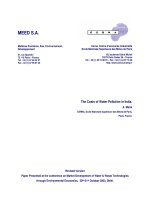THE ROLE OF MUSIC COMMUNICATION IN CINEMA potx
Bạn đang xem bản rút gọn của tài liệu. Xem và tải ngay bản đầy đủ của tài liệu tại đây (151.67 KB, 7 trang )
THE ROLE OF MUSIC COMMUNICATION IN CINEMA
Scott D. Lipscomb & David E. Tolchinsky
Northwestern University
ABSTRACT
[Authors’ note: This paper is an abbreviated version of a chapter
included in a forthcoming book entitled Music Communication (D.
Miell, R. MacDonald, & D. Hargreaves, Eds.), to be published by
Oxford University Press.]
Past research leaves no doubt about the efficacy of music as a means
of communication. In the following pages, after presenting a general
model of music communication, the authors will introduce models –
both empirical and theoretical – of film music perception and the role
of music in film, referencing some of the most significant research
investigating the relationship between sound and image in the
cinematic context. We shall then enumerate the many ways in which
the motion picture soundtrack can supplement, enhance, and expand
upon the meaning of a film’s narrative.
The relationship between the auditory and visual components in
cinema is both active and dynamic, affording a multiplicity of
possible relations than can evolve – sometimes dramatically – as the
narrative unfolds. This paper will take a cognitive approach to the
study of musical communication in cinema. As a result, much
credence will be given to the results of empirical research
investigating human cognitive processing in response to the motion
picture experience.
In conclusion, the present authors will argue for a more inclusive
definition of the term “film music” than that utilized or implied in
previous publications. In our view, film music is one component of
a sonic fabric that includes the musical score, ambient sound,
dialogue, sound effects, and silence. The functions of these
constituent elements often overlap or interact with one another,
creating a harmonious counterpoint to the visual image.
1. A MODEL OF MUSIC
COMMUNICATION
Many studies have investigated various aspects of musical
communication as a form of expression (Bengtsson & Gabrielsson,
1983; Clarke, 1988; Clynes, 1983, Gabrielsson, 1988, Seashore,
1967/1938; Senju & Ohgushi, 1987; Sundberg, 1988; Sundberg et al.,
1983). A tripartite communication model was proposed by
Campbell and Heller (1980), consisting simply of a composer,
performer, and listener. Using this previous model as a foundation,
Kendall and Carterette (1990) elegantly expanded upon this model of
music communication, detailing a process involving multiple states
of coding, decoding, and recoding. Kendall and Carterette suggest
that this process involves the “grouping and parsing of elementary
thought units” (p. 132), these “thought units” (metasymbols) are
mental representations involved in the process of creating,
performing, and listening to musical sound.
2. MODELS OF FILM MUSIC
COMMUNICATION
2.1 Empirical Evidence
Several researchers have proposed models specific to the perception
and cognition of music within the cinematic context. Initiating this
systematic effort, Marshall and Cohen’s (1988) bipartite
“congruence-associationist” model suggests that the meaning of a
film is altered by the music as the result of two complex cognitive
processes. Based upon subject responses, the researchers
determined that musical sound directly effects subject ratings on the
Potency (strong-weak) and Activity (active-passive) dimensions,
while the Evaluative dimension (good-bad) relies on the degree of
congruence between the audio and visual components on all three
dimensions, as determined by a “comparator” component. The
second part of the model describes how musical meaning is ascribed
to the film. Marshall and Cohen claim that attention is directed to the
overlapping congruent meaning of the music and the film. Referential
meanings associated with the music are ascribed to the overlapped
(congruent) audio-visual components upon which attention is
focused. As a result, “the music alters meaning of a particular aspect
of the film” (1988, p. 109).
Marshall and Cohen also acknowledge the important role played by
temporal characteristics of the sound and image, stating that “the
assignment of accent to events will affect retention, processing, and
interpretation” (1988, p. 108). Incorporation of this important
component of the developing model was provided by Lipscomb and
Kendall’s (1994) Film Music Paradigm, in which two implicit
processes are considered as the basis for whether attentional focus is
shifted to the musical component or whether it is likely to remain at
the subconscious – cognitively “inaudible” – level. The authors
suggested that these two implicit processes include an association
judgment (similar to Marshall and Cohen’s assessment of
“congruence”) and an evaluation of the accent structure relationship
between the auditory and visual components. Based on the results
of a series of three experiments utilizing stimuli ranging from
extremely simple, single-object animations to actual movie excerpts,
Lipscomb (1995) determined that the role of the two implicit
judgments appears to be dynamic such that, with simple stimuli
(such as that used in Lipscomb, 1995, Experiment 1 and Marshall &
Cohen, 1988), accent structure alignment plays a dominant role. As
the stimuli become more complex (e.g., multi-object animations and
actual movie excerpts) the primary determinant of meaning in the
auditory domain appears to shift to the associational judgment, with
the accent structure alignment aspect receding to a supporting role,
i.e., focusing audience attention on certain aspects of the visual image
(Boltz, 2001).
The most complex and fully developed model of film music
perception proposed to date is Cohen’s (2001)
“congruence-associationist framework for understanding film-music
communication” (p. 259; see Figure 1). This multi-stage model
attempts to account for meaning derived from the spoken narrative,
visual images, and musical sound. Level A represents bottom-up
processing based on physical features derived from input to each
perceptual modality. Level B represents the determination of
cross-modal congruence, based on both semantic (associational) and
syntactic (temporal) grouping features. Level D represents
top-down processing, determined by an individual’s past experience
and the retention of that experience in long term memory. According
to this model, the input from levels B (bottom-up) and D (top-down)
meet in the observer’s conscious mind (level C), where information is
prepared for transfer to short term memory. In its details, clearly
documented in Cohen (2001), this model is based on an assumption
of visual primacy, citing several studies that have suggested a
subservient role for the auditory component (Bolivar et al., 1994;
Driver, 1997; Thompson et al., 1994). Though a common
assumption throughout the literature, the present authors would like
to express reservation about this assumption and suggest that
additional research is required before such a claim can be supported
definitively.
Figure 1. Cohen’s “congruence-associationist framework.
2.2 Theoretical Evidence
Richard Wagner, creator of the idealized Gesamtkunstwerk in the
form of the 19
th
century music drama, claimed that “as pure organ of
the feeling, [music] speaks out the very thing which word speech in
itself can not speak out … that which, looked at from the standpoint
of our human intellect, is the unspeakable” (Wagner 1849/1964, p.
217). According to Suzanne K. Langer, “music has all the earmarks
of a true symbolism, except one: the existence of an assigned
connotation” and, though music is clearly a symbolic form, it remains
an “unconsummated symbol” (1942, p. 240). In order for a film to
make the greatest possible impact, there must be an interaction
between the verbal dialogue (consummated symbol), the cinematic
images (also, typically, a consummated symbol), and the musical
score (unconsummated symbol).
To answer the question “How does music in film narration create a
point of experience for the spectator?,” Gorbman (1987) suggests
three methods by which music can “signify” in the context of a
narrative film. Purely musical signification results from the highly
coded syntactical relationships inherent in the association of one
musical tone with another. Patterns of tension and release provide a
sense of organization and meaning to the musical sound, apart from
any extramusical association that might exist. Cultural musical
codes are exemplified by music that has come to be associated with a
certain mood or state of mind. These associations have been further
canonized by the Hollywood film industry into certain conventional
expectations – implicitly anticipated by enculturated audience
members – determined by the narrative content of a given scene.
Finally, cinematic codes influence musical meaning merely due to the
placement of musical sound within the filmic context. Opening
credit and end title music illustrate this type of signification, as well
as recurring musical themes that come to represent characters or
situations within the film.
There is a commonly held belief that film music is not to be heard
(Burt, 1994; Gorbman, 1987). Instead, it is believed to fulfill its role
in communicating the underlying psychological drama of the
narrative at a subconscious level (Lipscomb, 1989). There is,
however, certain music that is intended to be heard by the audience as
part of the cinematic diegesis, i.e., “the narratively implied
spatiotemporal world of the actions and characters” (Gorbman 1987,
p. 21). This “world” includes, naturally, a sonic component.
Therefore, all sounds that are understood to be heard by characters in
the narrative – including music – are referred to as diegetic, while
those that are not part of the diegesis (e.g., the orchestral score) are
referred to as nondiegetic. This would suggest that diegetic music is
more likely to be processed at the conscious level while nondiegetic
music might remain at the subconscious level, though research is
needed to determine whether this is true, in fact. It is worth noting
also, that the source of diegetic sound can be either seen or unseen.
Michel Chion (1990/1994) distinguishes these two types of diegetic
forms using the terms “onscreen” and “offscreen,” respectively (pp.
76-78).
Two extant models related to the role and function of film music are
particularly worthy of consideration. Gorbman (1987) compiled a
list of principles for composition, mixing, and editing in the
“classical” Hollywood film, emphasizing primarily the period
between the late 1930s and 1940s and based on the scores of Max
Steiner, composer of more than three hundred film scores (Thomas
1991), including King Kong (1933), Casablanca (1943), and Gone
With the Wind (1947). The seven principles were considered by
Gorbman as “a discursive field rather than a monolithic system with
inviolable rules” (p. 73). These principles included invisibility
(technical apparatus associated with nondiegetic music must not be
seen) and inaudibility (film music is not meant to be consciously
heard). Music is intended as a signifier of emotion. Music provides
referential and narrative cues. Music provides rhythmic and formal
continuity. And, finally, music aids in the construction of formal and
narrative unity. To confirm her intention that none of these
principles was to be considered sacrosanct, the seventh principle
states that “a given film score may violate any of the principles
above, providing the violation is at the service of the other
principles” (Gorbman, 1987, p. 73).
The second theoretical model is one proposed by Nicholas Cook
(1998), conceived for the express purpose of analyzing musical
multimedia. Like the present authors, Cook takes issue with the
oft-stated “fact” that music plays a subsidiary role to the image;
what he refers to as “the deceptive translucency of music” (p. 21).
Not content to settle for Gorbman’s classification of the
music-image and music-narrative relationship as “mutual
implication” (Gorbman, 1987, p. 15), Cook suggests considering the
various roles played by these components in terms of denotation and
connotation. He explains that “words and pictures deal primarily
with the specific, with the objective, while music deals primarily
with responses—that is, with values, emotions, and attitudes…. the
connotative qualities of the music complement the denotative
qualities of the words and pictures” (p. 22). Cook sets forth three
basic ways in which different media can relate one to another:
conformance, complementation, and contest. Predicated upon the
identification of similarities and differences between the component
media, the model provides a two-step process for determining the
existing relationship. The initial stage, identified as the “similarity
test,” involves the determination of whether component media are
consistent with one another. To apply this test to a motion picture,
one would ask “Is the same information being presented via both the
auditory and visual modalities?” To use Cook’s terminology, we are
asking whether the music and image are consistent or merely coherent,
i.e., providing a variant meaning or differential elaboration.
Ultimately, if we can state that the relationship is invertible without
changing the perceived meaning (i.e., it is equally valid to say that the
music projects the meaning of the image or the image projects the
meaning of the music), then the multimedia example has passed the
similarity test and the relationship exhibited is one of conformance.
In those instances where component media are determined to be
coherent rather than consistent (i.e., failing the similarity test), one
moves to the second step of the model: the “difference test.” The
answer to this query determines whether or not the inter-media
relationship is one of contradiction in which the meanings of the
component media are in opposition one to another, producing a
collision or confrontation. If such contradiction exists, the
relationship is one of contest. Otherwise, the relationship is one of
complementation – neither consistency nor contradiction – in which
the various media “are generally aligned with one another and share
the same narrative structure, but each medium elaborates the
underlying structure in a different way” (Cook, 1998, p. 102).
Cook’s model is quite useful, both as an analytical tool and as a
means of providing a consistent and coherent vocabulary for the
discussion of dynamic inter-media relationships.
3. WHAT FILM MUSIC CONVEYS
As confirmed by dozens of published theoretical t reatises, the words
of film music composers themselves, and the research cited
previously, it is undeniable that a film score, in its typical role, serves
to reinforce, alter, and/or augment the emotional content of a
cinematic narrative. In the following paragraphs, we will propose an
extended set of ways in which the soundtrack can serve to
communicate meaning through sound (including music), taking into
account the director’s – and, therefore, the composer’s – intentions,
the narrative content of the film, and the overall strategy of the
director in constructing the multifaceted soundtrack.
1
Our list will
include a variety of possibilities for the manner in which film music
may elicit emotional response and the many ways in which it can
function to convey the dramatic intentions of the film narrative.
3.1 General Mood of a Film
Musical sound provides a cue for the listener concerning whether the
narrative is intended to be perceived as scary, romantic, funny,
disturbing, familiar, comforting, other-worldly. In this capacity, the
role of music is significantly enhanced by the level of ambiguity
inherent in the visual scene. Specifically, the more ambiguous the
meaning of the visual image, the more influence is exerted by the
musical score in the process of interpreting the scene.
Music can convey the scope of a film, effectively communicating
whether the motion picture is an epic drama (Star Wars, 1977; Gone
With the Wind, 1947) or a story that exists on a more personal scale
(Ghost World, 2001). Music can convey the quality and size of a
space; what Gorbman refers to as “depth in space” or “physical
volumes” (1987, p. 25). For example, in Alien (1979) and Olivier's
Hamlet (1948) the music serves at times to make small and/or
artificial spaces seem more grand and to enhance the sense of realism.
In addition, music can establish a narrative’s placement in time.
Motion picture scores often serve to “authenticate the era” or to
provide a sense of nostalgia (Stuessy and Lipscomb 2003, pp.
410-411). Examples of the former would include Amadeus (1984)
and Immortal Beloved (1995), while a sense of nostalgia is
communicated through the music selected for films such as American
Graffiti (1973) and The Big Chill (1983).
Music can convey a sense of energy. In narrative theory and
screenwriting, it is understood that stories are often driven by the
manipulation of perceived energy. For example, a loaded gun
pointed directly at a character has a high level of potential energy,
while a post-coital couple has a low level of energy. Music can
reinforce energy at a given point in a film and/or the overall perceived
energy level of the film. Music is also capable of conveying the
overall perspective or message intended by the director, as related to
both characters and on-screen events. The same events can be
portrayed differently – resulting in changed audience interpretation –
by altering only the musical content (Bullerjahn & Güldenring, 1994;
Lipscomb & Kendall, 1994; Marshall & Cohen, 1988). Spaceships
can be portrayed as elegant and beautiful (2001: A Space Odyssey,
1968) or threatening machines of war (Star Wars, 1977). Boxing can
be portrayed as heroic (Rocky, 1976), strategic (When We Were
Kings, 1997), or tragic (Raging Bull, 1960). Based on the use of
different music and sound, the topic of war can be presented as brutal
and chaotic (battle scenes in Terminator 2: Judgment Day, 1991),
tragic (the “Letters” scene in Saving Private Ryan, 1999),
transcendent (the use of Samuel Barber’s “Adagio for Strings” in
Platoon, 1986), romantic and filled with adventure (Casablanca,
1942; African Queen, 1952), insane (Apocalypse Now, 1979; Barry
Lyndon, 1975), heroic (Schindler’s List, 1993; Glory, 1989), or even
comic (M*A*S*H, 1970). Borrowing from the field of linguistics,
Gorbman applies the term “ commutation” to describe the capability
of music to influence the meaning of a film in this way (1987, p. 16).
As an example of the dynamic manner in which cinematic meaning
can be manipulated by sound, the musical score is often used to
accompany montage sequences, conveying not only the passage of
time but implying changes that have occurred – personal,
interpersonal, or even global – during the intervening period (e.g., the
well-known “breakfast montage” from Citizen Kane; see Gorbman,
1987, p. 26).
3.2 Internal Life, Thoughts, and Feelings of a
Character
One of the most effective ways in which a musical score can augment
the narrative is to express the unspoken thoughts and unseen
implications that underlie the drama; what Prendergast refers to as
“psychological refinements” (1992, p. 216). Music can convey
character. Rather than just associating a character with a particular
musical theme, a director can choose to define a character by sound,
musical or non-musical. Without the sound, the character(s) would
cease to exist or be less than fully realized (e.g., the mother character
in Psycho or Hal in 2001: A Space Odyssey).
The most consistently used technique to communicate musically
through association is the leitmotif, used to great effect in Wagner’s
19
th
century music dramas (including Lohengrin, 1850; Tristan und
Isolde, 1857-59; Der Ring des Nibelungen, 1857-74). A leitmotif
is …
a theme, or other coherent musical idea, clearly defined so as
to retain its identity if modified on subsequent appearances,
whose purpose is to represent or symbolize a person, object,
place, idea, state of mind, supernatural force or any other
ingredient in a dramatic work.” (Whittall, 2003)
The history of film music is replete with examples of such recurring
themes, one of the most familiar is the set of themes composed by
John Williams for George Lucas’ Star Wars series … both the
original trilogy (Star Wars, 1977; The Empire Strikes Back, 1980;
and The Return of the Jedi 1983) and the two prequels released to the
present (Episode I: The Phantom Menace 1999; and Episode II:
Attack of the Clones 2002). The appearance of any of the character
themes serves an identical purpose to that of the leitmotif in the
Wagnerian music dramas.
3.3 Narrative Structure
In addition to communicating general mood or character
representation and development, a well-crafted musical score can
clarify – or even establish – a sense of order by presenting a clearly
perceived formal structure. According to Prendergast (1992),
“music can provide the underpinning for the theatrical buildup of a
scene and then round it off with a sense of finality” (p. 222). In films
that incorporate extant compositions (2001: A Space Odyssey, 1968;
32 Short Films About Glenn Gould, 1993), it is arguable that the
visual scene is structured around the musical form, rather than vice
versa. It is also possible that the shape of the music determines – or
assists in determining – the shape of the narrative. The appearance,
disappearance, and reappearance of musical sound can provide or
clarify the narrative structure of the film. There are instances in
which the narrative structure and the formal structure of the music
coalesce to create the resulting sense of order. The narrative in both
The Thin Blue Line (1988) and Magnolia (2000) can both be
perceived in a manner similar to the movements of a large-scale
musical composition. In this way, music can be used to emphasize
beginnings or endings. Likewise, a sense of structural unity is
provided by the recurrence of musical themes.
Music can convey messages about where in the frame the audience
should focus attention. Research has shown that music that is
assigned a “negative” or “positive” connotation “significantly biased
viewers’ interpretation and subsequent remembering of a film in a
mood-congruent fashion” (Boltz, 2001, p. 427). Specifically, when
music with an assigned connotation is combined with an ambiguous
scene, memory of objects in the visual scene is influenced
significantly by the music. In her discussion, Boltz states that
overall results from the recognition memory task illustrate
that music does not simply convey different moods that can
bias the interpretative framework or visual imagery of an
individual, even in the absence of an accompanying film.
Instead, music appears to exert a direct influence on the
cognitive processing of a film by guiding selective attending
toward mood-consistent information and away from other
information that is inconsistent with its affective valence. (p.
446; emphasis added)
In addition to mood congruent relations between audio and visual
components, salient moments in the musical sound draw attention to
salient events occurring concurrently within the visual image. This
“temporal coincidence” (Gorbman, 1987, p. 16) or “accent structure
alignment” (Lipscomb, in press; Lipscomb and Kendall, 1994) is an
important focusing device at the disposal of a film music composer
and can range on a continuum from Mickey-mousing (Alan
Silverstri’s score for the opening scene of Who Framed Roger Rabbit,
1983) to mid-range level synchronization (Bernard Herrman’s score
for the “shower scene” in Psycho, 1960) to the use of “stingers” as a
means of emphasizing significant events (examples from Max
Steiner’s score for Mildred Pierce are cited in Gorbman, 1987, p. 88).
Music can readily convey pace. By establishing patterns in the use
of music, sound effects, and silences and then manipulating these
established patterns within the temporal flow, a film can be made to
feel subjectively like it is speeding up or slowing down.
Alternatively, music can facilitate the continuity of or provide
background filler for the narrative; smoothing cuts between shots,
scene transitions, and filling “gaps” to serve as modern day incidental
music over scene changes (Gorbman, 1987, p. 34). Within a
cinematic context, the presence of film music serves to lower the
audience member’s “threshold of belief” (Gorbman, 1987, p. 6). The
fact that nondiegetic music is heard in places where it would not
appear as part of the diegesis, allows the audience to more readily
become lost in the drama.
4. CONCLUSIONS
Citing many empirical studies, this paper has shown that recent
research into the combination of sound and image is beginning to
reveal unambiguous ways in which the auditory component of a
motion picture adds depth and meaning to the cinematic experience.
Several of these studies have gone so far as to propose specific
models of film music perception (Cohen, 2001; Lipscomb, 1995;
Lipscomb & Kendall, 1994; Marshall & Cohen, 1988). In addition,
many scholars have developed unique theories regarding the various
ways in which the coexistence of sound and image symbiotically
produces affect in the audience member (Brown, 1988; Cook, 1998;
Gorbman, 1987; Wagner, 1849/1964). Though few who have
experienced a motion picture will deny the important role fulfilled by
the musical soundtrack, this chapter attempted to identify many
specific ways in which musical sound in this context can
communicate information to the listener, enhancing the filmic
experience.
Though the title for this paper includes the phrase “music
communication,” the present authors maintain that “music,” in a
cinematic context, may move beyond the boundaries of what is
typically recognized as such. Within a film, the soundtrack contains
not only the musical score, but ambient sound, dialogue, sound
effects, and silence, any of which may be either diegetic or
nondiegetic. We would argue that the composite mix of these sounds
becomes a complex communicative form that could be considered –
in toto – “music” (i.e., ordered sound), existing “in harmony” with
the visual image. As musical harmony can be consonant, dissonant,
or anywhere within the continuum between these two extremes, so
can the relationship between sound and image be consistent,
contradictory, or anywhere in between (Cook, 1998; Lipscomb &
Kendall, 1994). Expanding the definition of music is not an
unprecedented step to take and, in fact, a similar leap has already
been accomplished in the world of Western art music. For example,
many works by John Cage (4’33”, 1952; Radio Music, 1956) and
György Ligeti (Poème symphonique, 1962) challenge willing
listeners to reconsider their concept of what constitutes “musical
sound,” as the Dadaist movement of the early 20
th
century did for
visual art. The present authors’ analysis of 2001: A Space Odyssey
(Tolchinsky & Lipscomb, in preparation) reveals that, when music
is not present as part of the soundtrack, ambient sounds and
(quasi-)dialog can perform many of its typical functions. The roles
of each component of the soundtrack became more blurred as the
Hollywood film evolved toward the 21
st
century. Is it possible any
longer to separately consider – in the context of the dramatic scenes
of conflict in any segment of the Stars Wars saga, for example – the
function of John Williams’ massive orchestral score, the sound
effects, ambient sounds, etc.? The orchestral “hits” merge with the
sound effects and alternately share the spotlight with dialogue and
other salient auditory events … all supporting and augmenting the
emotional impact of the visual image. If the Star Wars example cited
above can be considered a representative example – and we believe it
can – it may be time to consider expanding the definition of “film
music.” Rather than insisting upon its consideration as a separate
and distinct entity, the present authors encourage analysis of the
entire soundtrack, upon which musical sound, dialogue, sound
effects, silence, and some sounds that fall in the cracks between
traditional categories all exist for the purpose of enhancing the
intended message of the motion picture. One might ask whether
music does have a unique function that rightly justifies its being set
apart from these other auditory components. Currently, there
appears to be an implicit assumption on the part of film theorists and
film music researchers, that the musical score is a separate entity.
There is certainly a benefit, especially within the context of
experimental investigations, in limiting the world of empirical
inquiry. We suggest, however, that as the field continues to mature,
the constituent elements that constitute the soundtrack should be
studied as a whole. Within the context of a finished film, roles of the
various individuals involved in the music communication process
become multifaceted and difficult – if not impossible – to disentangle
one from another. It may, in fact, be absolutely essential to revise the
basic components of Kendall and Carterette’s (1990) model of music
communication to include additional creative partners in the process.
The role of the composer, typically, is dramatically influenced by
the wishes and expressed input of the director (altered model
component: composer-director). The sonic component generated
by the performers involved in recording the score cannot be
separated from the role of the sound editor who is eventually
responsible for the manner in which the sound and image are
combined and the final audio-visual product (altered model
component: performer-sound editor). Finally, the listener is
transformed from a hearing-only individual into a listener-viewer.
Though the ideas expressed above may appear radical upon initial
consideration, they provide yet another means of moving from the
realm of reductionist method toward the ecologically valid world of
the Gesamtkunstwerk – or Gestalt – that cinema has become.
5. REFERENCES
Bengtsson, I. & Gabrielsson, A. (1983). Analysis and synthesis of
musical rhythm. In Studies of music performance (ed. J.
Sundberg), pp. 27-60. Royal Swedish Academy of Music,
Stockholm.
Bolivar, V.J., Cohen, A.J., and Fentress, J.C. (1994). Semantic and
formal congruency in music and motion pictures: Effects on the
interpretation of visual action. Psychomusicology, 13, 28-59.
Boltz, M. (2001). Musical soundtracks as a schematic influence on
the cognitive processing o filmed events. Music Perception,
18(4), 427-454.
Brown, R. (1988). Film and classical music. In Film and the arts in
symbiosis: A resource guide (ed. G.R. Edgerton), pp. 165-215.
New York, Greenwood Press.
Bullerjahn, C. and Güldenring, M. (1994). An empirical
investigation of effects of film music using qualitative content
analysis. Psychomusicology, 13, 99-118.
Burt, G. (1994). The art of film music. Northeastern University
Press, Boston, MA.
Campbell W. & Heller, J. (1980). An orientation for considering
models of musical behavior. In Handbook of music psychology
(ed. D. Hodges), pp. 29-36. National Association for Music
Therapy, Lawrence, KS.
Chion, M. (1994). Audio-vision: Sound on screen (C. Gorbman,
Trans.). Columbia University Press, New York. (Original work
published in 1990)
Clarke, E. (1988). Generative principles in music performance. In
Generative processes in music, (ed. J.A. Sloboda), pp. 1-26.
Clarendon Press, Oxford.
Clynes, M. (1983). Expressive microstructure in music, linked to
living qualities. In Studies of music performance (ed. J.
Sundberg), pp. 76-181.: Royal Swedish Academy of Music,
Stockholm.
Cohen, A.J. (2001). Music as a source of emotion in film. Oxford
University Press, New York.
Cook, N. (1998). Analysing musical multimedia. Oxford University
Press, New York.
Driver, J. (1997). Enhancement of selective listening by illusory
mislocation of speech sounds due to lip-reading. Nature, 381,
66-68.
Gabrielsson, A. (1988). Timing in music performance and its
relations to music experience. In Generative processes in music
(ed. J.A. Sloboda ), pp. 27-51. Clarendon Press, Oxford.
Gorbman, C. (1987). Unheard melodies: Narrative film music.
Indiana University Press, Bloomington, IN.
Kendall, R.A., & Carterette, E.C. (1990). The communication of
musical expression. Music Perception 8(2), 129-163.
Langer, S.K. (1942). Philosophy in a new key: A study of the
symbolism of reason, rite, and art (3
rd
ed.). Harvard University
Press, Cambridge, MA.
Lipscomb, S.D. (1989). Film music: A sociological investigation of
influences on audience awareness. Paper presented at the
Meeting of the Society of Ethnomusicology, Southern
California Chapter, Los Angeles.
Lipscomb, S.D. (1995). Cognition of musical and visual accent
structure alignment in film and animation. Unpublished
doctoral dissertation, University of California, Los Angeles.
Lipscomb, S.D. (in press). The perception of audio-visual
composites: Accent structure alignment of simple stimuli.
Selected Reports in Ethnomusicology, 12.
Lipscomb, S.D. and Kendall, R.A. (1994, Spring/Fall). Perceptual
judgment of the relationship between musical and visual
components in film. Psychomusicology, 13, 60-98.
Marshall, S.K. and Cohen, A.J. (1988). Effects of musical
soundtracks on attitudes toward animated geometric figures.
Music Perception, 6(1), 95-112.
Prendergast, R.M. (1992). Film music: A neglected art. W.W.
Norton and Co, New York.
Seashore, C.E. (1938). Psychology of music. McGraw-Hill, New
York. (Reprinted, New York: Dover, 1967)
Senju, M. & Ohgushi, K. (1987). How are the player’s ideas
conveyed to the audience? Music Perception 4, 311-323.
Stuessy, J., and Lipscomb, S. (2003). Rock and roll: Its history and
stylistic development (4
th
ed.). Prentice-Hall, Upper Saddle
River, NJ.
Sundberg, J. (1988). Computer synthesis of music performance. In
Generative processes in music (ed. J.A. Sloboda), pp. 52-69.
Clarendon Press, Oxford.
Sundberg, J., Frydén, L., & Askenfelt, A. (1983). What tells you the
player is musical? An analysis-by-synthesis study of music
performance. In Studies of music performance (ed. J. Sundberg),
pp. 61-67. Royal Swedish Academy of Music, Stockholm.
Thomas, T. (1991). Film score: The art & craft of movie music.
Riverwood Press, Burbank, CA.
Thompson, W.F., Russo, F.A., and Sinclair, D. (1994). Effects of
underscoring on the perception of closure in filmed events.
Psychomusicology, 13, 9-27.
Tolchinsky, D.E., and Lipscomb, S.D. (in prepation). 2001: A Space
Odyssey – “Music” in the absence of a score. Pre-publication
draft available from
< />/2001Analysis.pdf>
Wagner, R. (1964). Orchestra’s power of speech; analogy with
gesture. In Wagner on music and drama: A compendium of
Richard Wagner’s prose works (ed. A. Goldman and E.
Sprinchorn; H.A. Ellis, trans.). Dutton, New York. (Original
work [The Artwork of the Future] published in 1849)
Whittall, A. (2003). Leitmotif. In The new Grove dictionary of
music online (ed. L. Macy). Grove’s Dictionaries, New York.
[Retrieved August 16, 2003 from ]
1
Throughout this chapter we will use the term “director” as a
metonymy for the complex collaboration and decision-making process
involving composer, sound designer, screenwriter, editor, and
director … but which is ultimately shaped and controlled by the director,
to whom the responsibility for the final decision falls.









